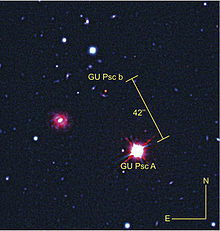astro.wikisort.org - Meteorite
GU Piscium b (GU Psc b)[2] is a directly imaged planetary-mass companion orbiting the star GU Piscium, with an extremely large orbit of 2,000 AU (3.0×1011 km), and an apparent angular separation of 42 arc seconds.[3][4] The planet is located at right ascension 01h 12m 36.48s declination +17° 04′ 31.8″ at a distance of 48 pc (160 ly).[1]
 The planet GU Piscium b and its star GU Piscium composed of visible and infrared images from the Gemini South telescope and an infrared image from the CFHT. Because infrared light is invisible to the naked eye, astronomers use a colour code in which infrared light is represented by the colour red. GU Piscium b is brighter in infrared than in other filters, which is why it appears red in this image. | |
| Discovery[1] | |
|---|---|
| Discovered by | Marie-Eve Naud, Étienne Artigau, Lison Malo, Loïc Albert, René Doyon, David Lafrenière, Jonathan Gagné, Didier Saumon, Caroline V. Morley, France Allard, Derek Homeier, Charles A. Beichman, Christopher R. Gelino, Anne Boucher |
| Orbital characteristics | |
Semi-major axis | 2000 AU[2] |
Orbital period (sidereal) | 163,000 years[NB 1] |
| Physical characteristics | |
| Mass | 9–13 MJ[2] |
Properties
An orbital revolution around its parent star (which is 1/3 the mass of the Sun) or "year", would take approximately 163,000 years[NB 1] to complete, considering a circular orbit with 2000 AU as the semi-major axis. It is a gas giant[5] located in the constellation of Pisces, 155 light-years from the Solar System, and estimated to have a mass nine to thirteen times that of Jupiter,[6] and a surface temperature of 1000 K.[7]
It is a relatively young stellar system, part of the AB Doradus moving group of ca. 30 main stars created from the same molecular cloud less than 100 million years ago, and the only one found among the 90 stars of the group examined.
Discovery
The discovery was made by an international team of astronomers led by Marie-Eve Naud of the Université de Montréal in Quebec, combining observations from telescopes of the Gemini Observatory, the Mont Mégantic Observatory (OMM), the Canada–France–Hawaii Telescope (CFHT) and the W. M. Keck Observatory.[8] Its large distance away from its parent star permitted the use of combined infrared and visible light images to detect it, a technique astronomers hope to reproduce to discover much closer planets with the Gemini Planet Imager (GPI) in Chile.
Near-infrared spectroscopy of the companion was obtained with the GNIRS spectrograph on the Gemini North Telescope, which shows evidence of low surface gravity confirming the planet's youth. Weak methane absorption was detected in H and K band corresponding to a spectral type of T3.5.
See also
- List of exoplanet extremes
- List of directly imaged exoplanets
- CFBDSIR 2149−0403 - Possible rogue planet in the AB Doradus moving group
- WD 0806−661 Y-type sub-brown dwarf. It is currently the planetary-mass object with the widest known separation from its host star and it has the widest angular separation as seen from Earth (more than 2 arcminutes).
Notes
- There is a mistake in the press release Archived May 21, 2014, at the Wayback Machine, that was repeated by various media. Using Kepler's 3rd law and assuming a circular orbit with a mass of 0.3 times the mass of the Sun for the star, the correct estimation of the period for this planet is ~163,000yr, not 80,000yr.
References
- Marie-Eve Naud; Étienne Artigau; Lison Malo; Loïc Albert; René Doyon; David Lafrenière; Jonathan Gagné; Didier Saumon; Caroline V. Morley; France Allard; Derek Homeier; Charles A. Beichman; Christopher R. Gelino; Anne Boucher (12 May 2014). "Discovery of a Wide Planetary-mass Companion to the Young M3 Star GU Psc". The Astrophysical Journal (published May 2014). 787 (1): 16. arXiv:1405.2932. Bibcode:2014ApJ...787....5N. doi:10.1088/0004-637X/787/1/5. S2CID 35264096. 5.
- Universite de Montreal (13 May 2014). "Odd planet, so far from its star: Gas giant 155 light years from our solar system". ScienceDaily. Retrieved 2014-05-14.
- Ivan Zolotukhin. "Planet GU Psc b". Exoplanet.eu.
- Université de Montréal (13 May 2014). "Odd planet, so far from its star..." UdeMNouvelles. Archived from the original on 2014-05-21.
- "Odd planet, so far from its star". Astronomy. May 14, 2014.
- "GU Psc b: Newly Discovered Exoplanet Takes 80,000 Years to Orbit its Star". Sci-News.com. May 14, 2014.
- Brett Smith (May 14, 2014). "Finding An Exoplanet That Takes 80,000 Earth Years To Orbit Its Sun". redOrbit.com.
- "Odd planet, so far from its star..." Gemini. May 12, 2014.
External links
- IOPscience: DISCOVERY OF A WIDE PLANETARY-MASS COMPANION TO THE YOUNG M3 STAR GU PSC
- arXiv: Discovery of a wide planetary-mass companion to the young M3 star GU Psc
- NASA ADS: Discovery of a Wide Planetary-mass Companion to the Young M3 Star GU Psc
На других языках
- [en] GU Piscium b
[ru] GU Рыб b
GU Рыб b — экзопланета (газовый гигант) или субкоричневый карлик в системе молодой переменной звезды GU Рыб. Находится в созвездии Рыб на расстоянии 156 световых лет от Земли[1].Другой контент может иметь иную лицензию. Перед использованием материалов сайта WikiSort.org внимательно изучите правила лицензирования конкретных элементов наполнения сайта.
WikiSort.org - проект по пересортировке и дополнению контента Википедии



